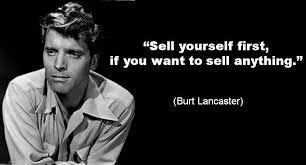What Do You Sell? How Do You Sell It?
To answer these questions, you need to begin by asking what your customers buy and why they buy it. Arming yourself with those answers may change the way you think about what you sell.
“What do you sell?” is a question I’ve asked at every sales training I’ve ever given and many seminar presentations. The answers are sometimes very intriguing. “Computers!” used to be the common answer. From the earliest days the Apple crowd replied “Solutions!” Others that have resonated more with me include “Peace of Mind” and “A Good Night’s Sleep.” I’ve heard manufacturers names, product names, types of services, and many more.
How a Sales Professional Answers
I’m told the very best answer I’ve ever heard originally came from a book written by actor Burt Lancaster. In it’s fullest form, the answer is…
“First you sell yourself.
Then you sell your company.
Then you sell your products & services”
Frighteningly, as a sales manager I’ve too often watched salespeople start at the end of that strategy. They launch right into their product pitch, extolling the virtues of the product and what it does. It’s amazing to watch how quickly the customer mentally checks out and stays checked out.
You Sell You
The art of selling is chock-full of popular axioms, and “sell yourself first” is just one of them.
Another very popular saying is, “People buy from people, and they buy most from people they like.”
Accepting that as wisdom, it follows that you want your customer to like you. For them to like you, they need to get to know you, and that’s why you sell yourself first. You introduce yourself and foster a more personal conversation so the customer can come to quickly know who you are and what you intend. You work to get them comfortable with you.
Many of the best sales professionals I’ve known will refer to their customers as their friends, and they are totally in earnest. They really do create a friendship with their customers. Beyond the value of making friends, these relationships pay dividends in many ways over a long period of time. Beyond the sales directly to that customer are the many new customers a friend will refer to you. They become your best promoters, your best advocates, even your best marketing!
Selling yourself requires a willingness to reveal yourself. The stories you tell about the experiences you’ve had form the connections of consanguinity as customers identify things you have in common. The more open you are and the more you reveal the more you generate the most important element of any relationship, especially a selling relationship:
Trust
IT services are usually business-critical. When we ask a customer to choose our services, we’re asking them to believe they can trust us to provide what they need to continue doing what they do. We get to earn and keep that trust by providing extraordinary service, but we must first earn it through our interaction with them. So, before they’ll buy anything else they have to buy into us and our trustworthiness.
The same is true for that second thing you’re going to sell, your company. Your customer must come to believe they can trust your company to deliver on everything you’ve promised. This can often put salespeople into contention with their own service people when they act as their customer’s best advocate, but that’s the “fail-safe” any company should appreciate. You need to know that everyone is working together to satisfy customers, even if that means occasional disagreements.
Once a customer believes that you’re acting in their best interests, and your company can be trusted to provide the best services, only then do you begin to present the products and services you’re offering, and even then only after you’ve determined what your customer wants and needs. If your products and services don’t align with your customer’s needs you’ll never be able to close that sell, and you shouldn’t be able to.
In other words, listen before you present.
The Worst Way to Get Started
You’ve seen it a million times. You visit a website or open a brochure or some other marketing collateral. Immediately you’re bombarded with who the sender is, how great they are at what they do, how their customers love them, and how long they’ve been doing this wonderful thing they do.
You don’t yet even know what they do, or if you should care about it.
It Isn’t About You,
It’s About Your Customer!
Here’s where those hurried salespeople make their big mistake. They think selling is about them. They feel compelled to start telling you how great their product is. They don’t even know if theirs is a product the customer would want to buy. Often, they don’t know anything about the customer at all. They just begin to spew.
Selling is not all about you. It’s all about your customer. It’s all about letting your customer know how important they are to you. We accomplish that by making the first conversation all about them. We ask them questions. We inquire into their history, their goals and aspirations, the things that concern them, and what success looks like for them.
Often, salespeople who get this far and have learned about their customer, then make the next common mistake. They begin to shower that customer with all the great features, functions, and the benefits of their products and services. They talk about speeds and feeds, capacities, capabilities, all of which may be great but only if they’re presented in the context of the customer. Ultimately, the customer only has one priority:
Value – The Context of the Customer
Many salespeople have learned to post pictures on their walls of the things they want most. For some its sports cars. For others, a boat, or a specific house, or a vacation venue. Whatever it is, it is meant to remind that salesperson of what they’re striving for, what they value most.
Value is the key.
Whenever we talk with a customer, we need to focus on and emphasize the value of whatever we’re talking about. But there’s a catch. When we talk about value we must define it from the perspective of the customer, not us. We may think a particular feature of our product is great, but we don’t know if that’s important to them.
Value From the Customer’s Perspective
This suggests an excellent way to think out everything you’re going to say. Instead of telling them what you have that’s wonderful, first confirm what’s valuable to them and then present what you have first as something they value and then how it delivers that value. Instead of saying, “Our security monitoring feature is top rated,” try saying “You need comprehensive monitoring to protect you from inbound threats, and ours is top rated.” Puts it in the perspective of the customer. Helps them identify with it.
Value is everything. We go into business to exchange value with others. For each of us, it is our responsibility to assure that customers understand, appreciate, and identify with the value we are offering them. Don’t wait and hope they’ll translate your features, functions, and benefits into the value it represents to them. Do that for them. Make it easier.
I often quote Covey’s 7 Habits, especially the one that says, “Begin with the end in mind.” Nowhere is this more applicable than in the selling process. Begin by asking exactly what value the customer wants to enjoy at the end of your sales process. Define that value in detail. Develop as much of an understanding of it as possible. Then target everything you present in the context of how it provides that value.
This Was Not Written Just for Salespeople
One of the challenges most service providers tell me they face is their inability to find and hire great salespeople. The same is true for engineers and other staff, but often their biggest concern is to find great salespeople. Fact is, the great ones are quickly gobbled up and treated very well to keep them aboard.
However, some of the most effective selling I’ve ever witnessed has been done by others. Network and Systems Engineers. Consultants. Technicians. And I’ve come to realize that all of those who have been so impressive have had one thing in common; they all always lead with value. They understand better than most what is important to their customer, what they need beyond what they think they may want. They can describe, in detail, how they’ve seen the same challenge at other customers’ sites and appreciate how much its costing.
These engineers not only know the technical specifications of the technologies they recommend and deploy, they have also taken the time to familiarize themselves with the costs of things. Most especially, they can very accurately advise their customer on the most cost-effective way to purchase software or cloud service licenses. In doing so, they provide additional value in the additional savings.
Value, value, value.
After reading this issue, consider speaking with your own technical staff. Get their perspectives on how they can better participate in the sales process. Get them thinking of themselves as professionals, like lawyers, accountants, even doctors. They don’t think of those people as salespeople, but none of them make a living until they convince clients or patients to engage them. That is definitely a selling activity. If they can do it, so can you.
In a professional practice, everybody sells.








Great approach. Ultimately, the buyer determines the value. And starting with your personal relationship is a great start. If the client doesn't "buy" you, they certainly won't buy anything else.